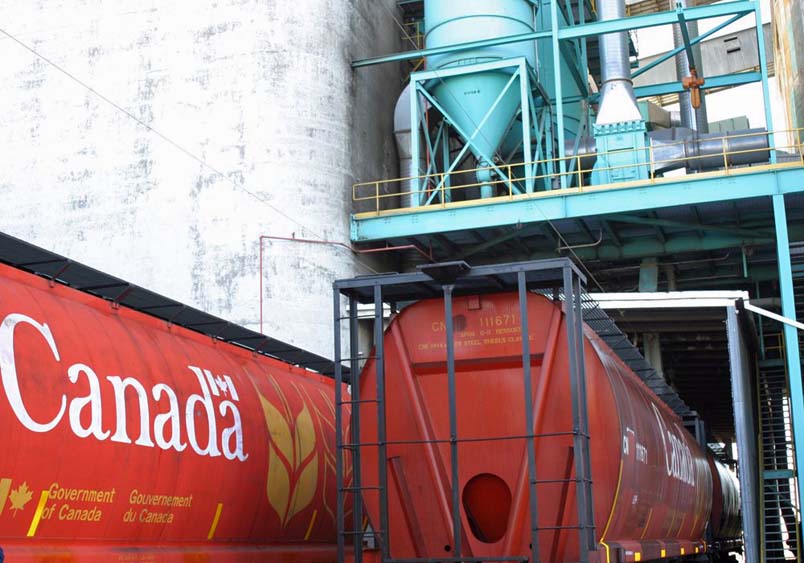

Canada - Western Canadian grain farmers will pay more money to move this year's crop to export position.
According to multiple sources, grain freight rates on some regulated railway routes have already risen by more than 12 percent since 1 Sep 2019.
"We've seen our freight rates on Canadian Pacific (CP) go up by nearly 13 percent over the past two months," said one small-block shipper who asked
that his identity be withheld.
"I think they went up more than seven percent in September, and it looks like we just got another five percent increase this week It's a lot. It
absolutely is a lot."
Added Perry Pellerin, president of the Western Canadian Shortline Railway Association, "These days, we're seeing lots of rate changes because both
railways have put a lot of time and effort into trying to manage their revenue caps. You'll often see railways raise or lower rates, and then raise them again,
depending on what they're seeing for grain volumes and that type of thing. They're trying as best as they can to come in as close as they possibly can to the
cap, and in doing that we are constantly seeing more rate adjustments."
Pellerin agreed that rates at some CP service locations have jumped by 11 to 13 percent since late summer.
A more telling measurement of freight rate increases, he suggested, is a year-over-year comparison.
By that measure, published rates for both railways appear to be up by five to nine percent.
That's a tough pill to swallow for farmers who are facing difficult harvest conditions this year and dealing with a low-quality crop.
Wade Sobkowich, executive director of the Western Grain Elevators Association said WGEA members have also reported rate hikes in the range of 12 percent since
late summer.
Sobkowich said larger-than-normal increases at CP may be an indication that the company is managing revenues under the maximum revenue entitlement formula more
aggressively this year.
It is possible CP will make downward adjustments at a later date to avoid financial penalties linked to MRE overages, he added.
WGEA members anticipated an annualized freight rate increase of around four percent in the current crop year, he said.
The rate hikes experienced so far this crop year have caught some shippers by surprise.
They've also prompted some questions about rate transparency.
In some cases, grain freight rates are published.
But in other cases, rates and incentives are contained in confidential contracts.
So while some facilities are paying published rates, others, including modern, efficient, mainline loop-track loaders, may be paying at a lower, undisclosed
rate.
The unnamed small block shipper said the lack of rate transparency could lead to a two-tiered pricing structure that will push more grain to main-line
delivery locations.
Pellerin said the WCSLRA has been observing rates at different loading locations.
"I think what we're seeing creep in a little more nowadays is confidential contracts," he said.
"So when you have a big terminal that can load a unit train in 12 hours, for example, there's the potential, let's say, for confidential contracts that
would offer lower rates."
Both Pellerin and Sobkowich said rate increases early in the 2019-2020 crop year were not unexpected.
In May 2018, the passage of the Transportation Modernization Act resulted in an amended MRE formula and created an environment that was more conducive to
capital investments by railway companies.
Among other things, the MRE changes allowed railway companies to recoup the full value of capital invested in new grain hopper cars.
Within days of the changes, both CN and CP announced plans to invest in new high-volume grain hoppers.
CP announced plans to invest $500 million over five years on 5,900 new "high-cube" hoppers.
By the end of 2019, nearly 1,900 of those cars will be in service, CP officials said.
CN announced plans to acquire 1,000 high-cube cars at an undisclosed cost.
About 500 of CN's new cars are already in service, with the remaining 500 due to come online in January 2020.
The passage of the transportation act, and the renewal of Canada's grain hopper car fleet, were generally welcomed by stakeholders in the grain
industry.
However, some observers cautioned that the implications for grain shippers and farmers wouldn't be fully understood for years.
In a June 2018 interview, Greg Northey, an expert with Pulse Canada, called the MRE program an important price protection mechanism for growers, but he
questioned the relevance of some base-line costs in the MRE that were established in the 1990s.
He also conceded that the formula used to determine maximum grain revenues is not well understood.
"This is such a black box, trying to figure out how the MRE is calculated," Northey said.
"If the railways keep on reducing their per unit costs, which they have done over the lifetime of the MRE, it just means more profit for them, even within
the MRE formula."
"We definitely need to watch the situation and make sure there's not some kind of obvious downloading on farmers. That said, I think we can definitely
expect some changes in how the railways structure their pricing."
Brian Cross.
provisions in Section 29 of the Canadian
Copyright Modernization Act.

